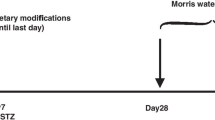Abstract
We aim to study the therapeutic efficacy of analog P165 of amyloid precursor protein 5-mer peptide in streptozotocin (STZ)-induced cognitive decline model. Rats were divided into four groups: control, STZ, STZ+P165, and STZ+rosiglitazone (RSG). STZ model was established by intracerebroventricular injection of STZ. Three weeks following surgery, rats received daily gavage administration of distilled water (control and STZ groups), P165 (STZ+P165), or RSG (STZ+RSG) for four consecutive weeks. Learning and memory abilities were assessed with the Morris water maze test. Insulin-like growth factor-1 (IGF-1) was detected by ELISA. Expressions of insulin receptor-β (IR-β), insulin receptor substrate-1 (IRS-1), serine/threonine kinase (Akt), and phosphorylation of CREB (p-CREB) were observed by immunohistochemistry. Both P165 and RSG significantly reduced the escape latency relative to the STZ group (P165, P < 0.05; RSG, P < 0.01). STZ model rats had reduced levels of IGF-1 relative to control, and this deficit was attenuated in the STZ+P165 group (P < 0.01). IR and IRS-1 were elevated in STZ rats, and these levels were restored to near control in the STZ+P165 and STZ+RSG groups (P < 0.01). Our findings demonstrate that P165 and RSG improved hippocampus-dependent spatial learning and memory in STZ rats by regulating the insulin signaling pathway.




Similar content being viewed by others
References
Reitz C, Brayne C, Mayeux R (2011) Epidemiology of Alzheimer disease. Nat Rev Neurol 7:137–152
de la Monte SM, Wands JR (2005) Review of insulin and insulin-like growth factor expression, signaling, and malfunction in the central nervous system: relevance to Alzheimer’s disease. J Alzheimers Dis JAD 7:45–61
Hoyer S, Lee SK, Loffler T, Schliebs R (2000) Inhibition of the neuronal insulin receptor. An in vivo model for sporadic Alzheimer disease? Ann N Y Acad Sci 920:256–258
Plaschke K, Hoyer S (1993) Action of the diabetogenic drug streptozotocin on glycolytic and glycogenolytic metabolism in adult rat brain cortex and hippocampus. Int J Dev Neurosci Off J Int Soc Dev Neurosci 11:477–483
Sharma M, Gupta YK (2001) Intracerebroventricular injection of streptozotocin in rats produces both oxidative stress in the brain and cognitive impairment. Life Sci 68:1021–1029
Shuli S, Yongmei Z, Zhiwei Z, Zhijuan J (2001) beta-Amyloid and its binding protein in the hippocampus of diabetic mice: effect of APP17 peptide. Neuroreport 12:3317–3319
Liu Y, Liu F, Grundke-Iqbal I, Iqbal K, Gong CX (2011) Deficient brain insulin signalling pathway in Alzheimer’s disease and diabetes. J Pathol 225:54–62
Agrawal R, Tyagi E, Shukla R, Nath C (2009) A study of brain insulin receptors, AChE activity and oxidative stress in rat model of ICV STZ induced dementia. Neuropharmacology 56:779–787
Agrawal R, Mishra B, Tyagi E, Nath C, Shukla R (2010) Effect of curcumin on brain insulin receptors and memory functions in STZ (ICV) induced dementia model of rat. Pharmacol Res Off J Ital Pharmacol Soc 61:247–252
Morris R (1984) Developments of a water-maze procedure for studying spatial learning in the rat. J Neurosci Methods 11:47–60
White MF (1998) The IRS-signalling system: a network of docking proteins that mediate insulin action. Mol Cell Biochem 182:3–11
Moloney AM, Griffin RJ, Timmons S, O’Connor R, Ravid R, O’Neill C (2010) Defects in IGF-1 receptor, insulin receptor and IRS-1/2 in Alzheimer’s disease indicate possible resistance to IGF-1 and insulin signalling. Neurobiol Aging 31:224–243
Talbot K, Wang HY, Kazi H, Han LY, Bakshi KP, Stucky A, Fuino RL, Kawaguchi KR, Samoyedny AJ, Wilson RS, Arvanitakis Z, Schneider JA, Wolf BA, Bennett DA, Trojanowski JQ, Arnold SE (2012) Demonstrated brain insulin resistance in Alzheimer’s disease patients is associated with IGF-1 resistance, IRS-1 dysregulation, and cognitive decline. J Clin Invest 122:1316–1338
Franke TF (2008) PI3K/Akt: getting it right matters. Oncogene 27:6473–6488
Osada M, Tolkacheva T, Li W, Chan TO, Tsichlis PN, Saez R, Kimmelman AC, Chan AM (1999) Differential roles of Akt, Rac, and Ral in R-Ras-mediated cellular transformation, adhesion, and survival. Mol Cell Biol 19:6333–6344
Porte Y, Trifilieff P, Wolff M, Micheau J, Buhot MC, Mons N (2011) Extinction of spatial memory alters CREB phosphorylation in hippocampal CA1. Hippocampus 21:1169–1179
Thomas J, Garg ML, Smith DW (2013) Altered expression of histone and synaptic plasticity associated genes in the hippocampus of streptozotocin-induced diabetic mice. Metab Brain Dis 28:613–618
Freude S, Schilbach K, Schubert M (2009) The role of IGF-1 receptor and insulin receptor signaling for the pathogenesis of Alzheimer’s disease: from model organisms to human disease. Curr Alzheimer Res 6:213–223
Wang P, Jiang S, Cui Y, Yue Z, Su C, Sun J, Sheng S, Tian J (2011) The n-terminal 5-MER peptide analogue P165 of amyloid precursor protein exerts protective effects on SH-SY5Y cells and rat hippocampus neuronal synapses. Neuroscience 173:169–178
Acknowledgments
This work was supported by the following grants: Beijing Natural Science Foundation (7132044), Capital Health Development Research Fund (2011-1001-02), Beijing Health Systems, Health and Technical Personnel of High-level Plan (2009-3-64).
Conflict of interest
None.
Author information
Authors and Affiliations
Corresponding author
Electronic supplementary material
Below is the link to the electronic supplementary material.
10072_2014_1849_MOESM1_ESM.pdf
Supplementary Figure S1. Histological examination of hippocampal CA1 and CA3 neurons from different groups. Sections were stained with HE. Magnification, 100X. (PDF 332 kb)
Rights and permissions
About this article
Cite this article
Xu, BL., Wang, R., Meng, XH. et al. Effects of analog P165 of amyloid precursor protein 5-mer peptide on learning, memory and brain insulin receptors in the rat model of cognitive decline. Neurol Sci 35, 1821–1826 (2014). https://doi.org/10.1007/s10072-014-1849-7
Received:
Accepted:
Published:
Issue Date:
DOI: https://doi.org/10.1007/s10072-014-1849-7




